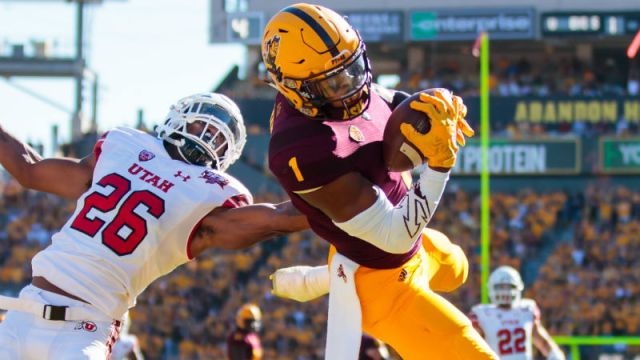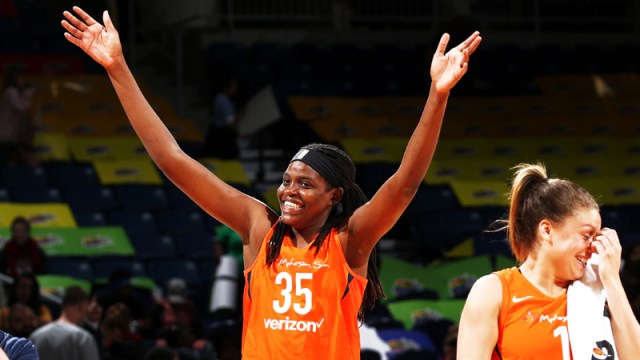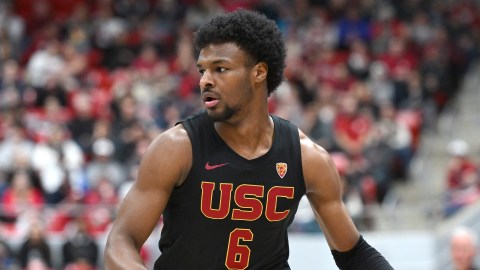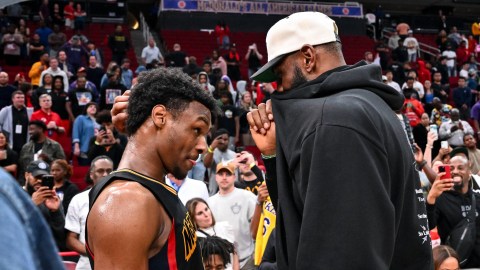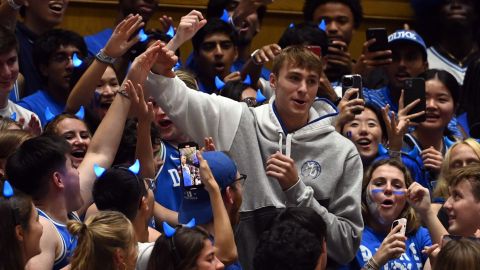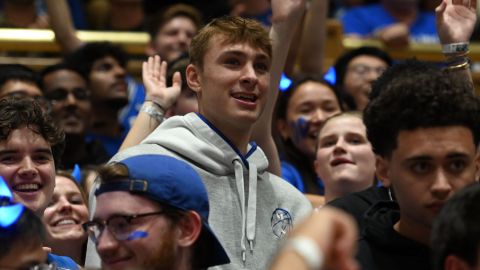With the lottery complete and the NBA draft order set, we now know the New Orleans Pelicans hit the jackpot.
It’s only a matter of time until Zion Williamson settles down in the Crescent City, but the rest of the draft remains a mystery.
Here are our early projections for the first 30 picks:
1. New Orleans Pelicans: Zion Williamson, F, Duke (6-foot-7, 272 pounds)
The Duke product is a never-before-seen specimen who’s as athletic as they come. Williamson was college basketball’s best player from start-to-finish this season, and he’ll bring that same star power to New Orleans. The 6-foot-7 forward is a no-brainer from both a basketball and business standpoint.
Will he be enough to get Anthony Davis to stay? Probably not. But he certainly gives vice president of basketball operations David Griffin a lot of fresh leverage heading into what is sure to be a busy offseason.
2. Memphis Grizzlies: Ja Morant, PG, Murray State (6-foot-3, 170 pounds)
Morant is a fascinating prospect, whose most popular comparison seems to be Russell Westbrook, even though he’s more of a John Wall. At 6-foot-3, the 19-year-old has crazy athleticism, which pushes his ceiling to an extreme level. His north/south speed rivals that of Wall, allowing him to be unbelievably effective in transition.
Morant shouldn’t have many issues transitioning into an NBA offense thanks to his strong ability in pick-and-roll sets. He’ll need to improve his decision making and become a more consistent shooter, but his work ethic will work in his favor.
The Grizzlies will likely trade point guard Mike Conley now that they’ve snagged the No. 2 slot. Either way, Memphis now has luxurious backcourt problems.
3. New York Knicks: RJ Barrett, SF, Duke (6-foot-7, 208 pounds)
Barrett is a great scorer who was overshadowed by the Zion madness at Duke this season. Despite losing out on the No. 1 pick, Knicks fans should be happy with Barrett, as he fits nicely with their current roster. He’s a solid passer who can act as the primary ball-handler, while he’s also shown to be great on the glass for his size.
He’ll need to improve his perimeter game and lackluster court vision, but Barrett is the best fit for New York at No. 3.
4. Los Angeles Lakers: Jarrett Culver, SG, Texas Tech (6-foot-6, 195 pounds)
Culver really burst into the spotlight when his Red Raiders reached the Final Four, but the 20-year-old struggled late in his NCAA Tournament run. Despite the disappointing performance, he brings great versatility into the Lakers’ backcourt. If he’s able to improve his ball handling, he’s a sure thing at the wing.
Culver has received some criticism for his slow shot release, but the bigger concern is his lack of explosiveness on the perimeter. He’ll need to address this issue to beat defenders off the dribble, but Culver would be a nice fit next to Lonzo Ball for a team that’s needed a solid two-guard for quite some time.
5. Cleveland Cavaliers: De’Andre Hunter, SF, Virginia (6-foot-8, 222 pounds)
Hunter’s defensive versatility combined with his 3-and-D potential makes him an easy top-10 pick. He can arguably guard any spot on the floor thanks to his quickness and size, while possessing a consistent spot-up shot at the other end.
With arguably the highest floor of any prospect in the class, Hunter can be a key part of Cleveland’s long-term rebuild.
6. Phoenix Suns: Darius Garland, PG, Vanderbilt (6-foot-3, 173 pounds)
Garland missed the majority of the year due to a season-ending knee injury, but the score-first point guard has a perfect pick-and-roll game. He can shoot off the dribble and has a quick release, which he’ll use working on or off the ball. Garland benefits from this class’ lack of point guard depth, despite his injury creating some durability questions.
Defensive concerns at the professional level are definitely relevant due to his lack of size and strength, but Phoenix’s desperate need for a point guard will cause them to take a flyer on his high upside. His shot-creating ability would take some of the heat off of Devin Booker — something the Suns desperately need.
7. Chicago Bulls: Coby White, PG, North Carolina (6-foot-5, 191 pounds)
White is extremely quick and has shown the ability to play well both on and off the ball. The 6-foot-5 guard is very dangerous in transition and is a threat for any fast-paced offense. His size is a major plus, especially for a team like the Bulls who seem ready to bail on former lottery pick Kris Dunn. If they elect to play both White and Dunn, that’s where his off-ball skills come into play.
He’s an above average shot maker who thrives in the open floor. In other words, NBA spacing is perfect for his game. White’s half-court game is still a bit raw, but as a bucket-getter, he’ll be able to produce as that part of his game develops.
8. Atlanta Hawks: Cam Reddish, SF, Duke (6-foot-9, 205 pounds)
Reddish will be the last of the Duke trio selected, but his offensive potential should keep him in the top 10. The 6-foot-8 wing can certainly score, but he doesn’t have a great motor, which leads to a lack of flow in his game.
His combination of size and talent will ideally allow him to fit into any NBA offense seamlessly, but his productivity at Duke left plenty to be desired. Reddish would provide a nice perimeter scoring punch alongside Atlanta’s young core of Trae Young, John Collins and Kevin Huerter.
9. Washington Wizards: Sekou Doumbouya, PF, France (6-foot-9, 210 pounds)
The Wizards are staring at a long-term rebuild, which allows them to take interest into players who are set up to be projects. Doumbouya is one of those, as the 18-year-old has plenty of upside with great length and solid mobility at 6-foot-9.
He’s still very raw and doesn’t have great hands, but he’s only 18. If Doumbouya can become a reliable shooter, his overall game would skyrocket. He’s already shown defensive promise during his time in Pro A France. Doumbouya will need a bit more time than most prospects, but his multi-dimensional game is intriguing, to say the least.
10. Atlanta Hawks (via Dallas Mavericks): Jaxson Hayes, C, Texas (7-foot, 220 pounds)
Hayes was a late bloomer, but his athletic ability and frame allow him to stretch the floor effectively. Picture JaVale McGee but with a better motor and defensive game (terrific shot blocker).
He’s still very raw and will need to work on his interior game, but an athletic big who moves well laterally is always a good start. Hayes’ game fits that of a solid modern day rim-running center.
11. Minnesota Timberwolves: Rui Hachimura, PF, Gonzaga (6-foot-9, 234 pounds)
The Japanese-born forward has an interesting skill set, which creates plenty of mismatches for opposing teams. Hachimura is athletic for his size and exemplifies great work ethic that any team would love to add.
He’s still a raw talent with plenty of room to improve, especially in the speed and interior departments, but he’s trending in the right direction. A versatile big man next to Karl-Anthony Towns will be tempting for the Wolves. This may be a bit early for the Gonzaga product, but it would be a good fit.
12. Charlotte Hornets: Brandon Clarke, PF, Gonzaga (6-foot-8, 210 pounds)
Clarke is a defensive-minded forward who is ready to contribute immediately at the NBA level. He can jump out of the gym and uses his strong basketball IQ to his advantage on defense.
Clarke has a unique skillset and impressed during his combine drills. If his pick-and-roll game translates to the professional level, he’s one of the more NBA-ready prospects in the class.
13. Miami Heat: Bol Bol, C, Oregon (7-foot-2, 222 pounds)
Bol Bol is arguably the most intriguing player in this class. He can shoot from deep and is a great shot blocker, but his motor is very concerning alongside his questionable durability. The Oregon product has a lot of offensive upside but will need to convince teams that the red flags aren’t as alarming as many feel they are.
14. Boston Celtics (via Sacramento Kings): Kevin Porter Jr., SG, USC (6-foot-6, 217 pounds)
Porter Jr. is a polarizing prospect to say the least. He’s a lottery talent with a plethora of concerns. Injuries and a lack of work ethic will keep him from the top 10, but this kid can score. If he pans out, he’ll be an absolute steal.
The Celtics are a team that isn’t afraid to take a chance on a young player with some high upside. Last year, they selected Robert Williams, a lottery talent who fell out of the top-14 due to durability and work ethic questions. Danny Ainge could make a similar selection in 2019.
15. Detroit Pistons: Romeo Langford, SF, Indiana (6-foot-6, 202 pounds)
Langford didn’t have a great 3-point shooting season, but much of that likely was the result of an injured shooting hand. He’s a prototypical NBA wing but needs to work on his court vision and limit turnovers.
To his advantage, he’s a great scorer, extremely athletic and has a good frame for an NBA wing. There’s no reason to believe he won’t be a pro bucket-getter, especially if he can create his own shot in pick-and-roll sets.
16. Orlando Magic: Nassir Little, SF, North Carolina (6-foot-6, 215, pounds)
Little is an explosive wing who underperformed for the majority of his season at UNC, but he still has great upside.
His toughness and strength allow him to defend multiple positions, giving him 3-and-D potential. Little is still very raw and struggles to make adjustments on the fly, which will likely cause him to fall out of the lottery.
17. Brooklyn Nets: PJ Washington, PF, Kentucky (6-foot-8, 223 pounds)
Washington benefited from returning to Lexington for his sophomore year. He plays like a guard but is 6-foot-8 with a 7-foot-3 wingspan. Not bad for someone with solid court vision and an awesome ability to find the open man.
He can defend multiple positions, has good size and improved multiple facets of his game during his sophomore season.
18. Indiana Pacers: Nickeil Alexander-Walker, SG, Virginia Tech (6-foot-6, 200 pounds)
The 6-foot-5 guard can play on or off the ball, which is a huge improvement from where he was during his freshman season with the Hokies. His length, high IQ and creative scoring ability could make him one of the biggest steals of the draft if he falls.
Alexander-Walker is very similar to Shai Gilgeous-Alexander, and not just because of the hyphen.
19. San Antonio Spurs: Cameron Johnson, PF, North Carolina (6-foot-9, 210 pounds)
Floor spacing is important in the NBA, and long shooters make that much easier to achieve. Johnson is exactly that, in addition to his strong transition game. Durability is concern due to his history with hip problems, but his IQ will draw a team like San Antonio to him.
At 23, he’s one of the older prospects in the class and should contribute immediately.
20. Boston Celtics (via L.A. Clippers): Tyler Herro, SG, Kentucky (6-foot-5, 193 pounds)
Herro can knock down shots from anywhere on the floor and is a good defender. He can’t yet create his own shot, but ideally, a good system like Boston’s will help that come to form.
He’s extremely skilled at running off screens in a variety of sets while bringing a surprising toughness to the defensive end. Don’t be surprised if Herro climbs draft boards over the next month.
21. Oklahoma City Thunder: Goga Bitadze, C, Georgia (6-foot-11, 251 pounds)
At 19, Bitadze (from Georgia, the country) has shown the ability to play against high levels of competition. He can effectively stretch the floor, but is he the next Jokic? Who knows. International scouting remains a mystery.
22. Boston Celtics: Keldon Johnson, SF, Kentucky (6-foot-6, 210 pounds)
Johnson is a really hard worker who’s a plus defender with a smart offensive game. His off-ball flow needs improvement, and he has below-average athleticism, but Johnson’s effort and talent alone lead people to realize his potential as an immediate impact player.
The Kentucky product isn’t the greatest ball handler, but if he ends up on a team like Boston, that won’t matter.
23. Utah Jazz: Grant Williams, PF, Tennessee (6-foot-6, 221 pounds)
He’s not a great athlete and isn’t a deep threat (yet), but Williams is a team-first guy who plays his butt off. He has a good touch inside but will need his outside game to develop if he wants to really contribute at the next level.
The 20-year-old is tough as nails and his defensive IQ will help any club.
24. Philadelphia 76ers: Talen Horton-Tucker, SG, Iowa State (6-foot-4, 239 pounds)
Versatility is the key factor with Horton-Tucker. His size allows him to guard multiple positions and fill different roles on the offensive end.
His age (18), ability to shoot off the bounce and length combine to make him a fascinating prospect. It all depends on how his future team uses him, but Horton-Tucker will need to become a consistent shooter to be a valued contributor.
25. Portland Trail Blazers: Luguentz Dort, SG, Arizona St. (6-foot-5, 224 pounds)
Dort can defend bigger guards along the perimeter, while also sticking with quicker ones when given that challenge. He’s very strong for a two-guard but will need to show some versatility on offense in his pre-draft workouts to help his stock.
The Western Conference is loaded with guards, so a defender like Dort is attractive for teams like Portland looking to add backcourt stoppers.
26. Cleveland Cavaliers (via Houston Rockets): Ty Jerome, SG, Virginia (6-foot-5, 200 pounds)
Jerome is a pure shooter who can play multiple spots. At 6-foot-5, he provides defensive length needed from guards in today’s NBA. That and his playmaking ability, give him a game fit for the pros.
He’s a catch-and-shoot-killer who uses his basketball IQ to read screens to benefit his shot creation. Despite some concerns about his quickness, his skillset alone should make a late first-rounder.
27. Brooklyn Nets (via Denver Nuggets): KZ Okpala, SF, Stanford (6-foot-9, 210 pounds)
If he continues to improve his perimeter game, Okpala’s impressive athleticism could make him a hybrid 3-and-D player. Good court vision, solid basketball IQ, and a good passing ability sounds like a nice combination, right?
He’s still extremely raw but has intriguing playmaking abilities that could lead someone to take a flyer on him late in the first.
28. Golden State Warriors: Carsen Edwards, PG, Purdue (6-foot, 196 pounds)
Those who watched the NCAA Tournament know what Edwards can do.
The 21-year-old can play on or off the ball whose range extends to the parking lot. He’s a bit undersized and hasn’t shown great playmaking ability, but he projects to be a solid backup point guard wherever lands.
29. San Antonio Spurs (via Toronto Raptors): Matisse Thybulle, SF, Washington (6-foot-5, 200 pounds)
Thybulle is an outrageously good defender at 6-foot-5, who has the ability to disrupt any level of guard along the perimeter. The 22-year-old has plenty of experience under his belt and will be ready to contribute as a high-level defender wherever he lands.
30. Milwaukee Bucks: Chuma Okeke, F, Auburn (6-foot-8, 230 pounds)
Okeke tore his ACL in the Sweet 16 during this year’s NCAA Tournament, which will unfortunately kill his draft stock. The Auburn product being selected at No. 30 is a positive outlook, but he’ll likely fall out of the first round due to the injury.
